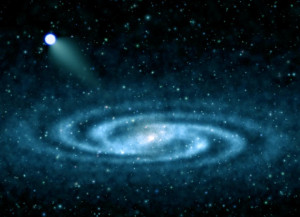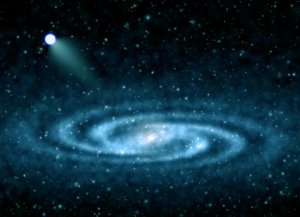
Earlier this year FQTQ reported on real-life shooting stars, and recently a new shooting star has been found! Real shooting stars are sun-like objects, varying in size, traveling at astronomical speeds. Conversely, when most people refer to shooting stars, they are actually talking about meteoroids, space debris that burns up as it passes through our atmosphere creating a meteor shower. The real-life shooting stars have little in common with meteors. They are believed to have once been part of a binary system. Imagine two suns bound to each other by gravity; now imagine them careening towards Sagittarius A*, the black hole in the center of our Milky Way. The force of the black hole captures one of the stars eternally; in doing so it thrust the other outward into the depths of space at speeds upwards of 2 million miles per hour! This velocity renders it gravitationally unbound to our galaxy. Such rapidly moving objects are known as hypervelocity stars.
THE PROVERBIAL NEEDLE IN A HAYSTACK:

Only a handful (about 20) of such stars have been discovered to date. It is theorized that hypervelocity stars are ejected by Sagittarius A* only once every hundred thousand years, making them rare occurrences. With the help of an international team of scientists, Zheng Zheng, assistant professor of physics at University of Utah, is shedding light on these elusive speeding stars. Zheng details his discovery of a new hypervelocity star in a recent publication of The Astrophysical Journal Letters. The newly found star goes by the name LAMOST-HVS1; its name comes from the telescope used to uncover it: the Large Sky Area Multi-Object Fiber Spectroscopic Telescope (LAMOST), part of the National Astronomical Observatory in China. In a press release provided by the University of Utah, Zheng states LAMOST-HVS1 “is the nearest, second-brightest, and one of the three most massive hypervelocity stars discovered so far”.
LAMOST-HVS1’S MOST STRIKING CHARACTERISTICS:
- The star is traveling at 1.4 million miles per hour relative to our solar system, this well over its normal rate of 500,000 miles per hour.
- It is located 249 quadrillion miles away from Earth, that’s 249 with fifteen zeros behind it. This may not seem close; however, take into consideration that the Milky Way is about 100,000 light-years in diameter and a thousand light-years thick. The observable universe as a whole is incredibly vast; most sources put it at between 90-150 billion light-years across. So having LAMOST-HVS1 only 42,400 light-years away practically makes us neighbors.
- Based on the speed and trajectory of the star, Zheng has put its age at 32 million years old, which is a youngster compared to our Sun, which has existed for the last 4.6 billions years.
- From its location in the cosmos, the star has a magnitude of 15, which is quite faint based on our location. However, if LAMOST-HVS1 and our Sun were put side by side, the star would outshine our Sun tremendously. It is 3,400 times brighter, in fact. This is because it 4 times hotter and 9 times more massive!
THE QUEST TO UNDERSTAND DARK MATTER:
By taking measurements of the new star’s trajectory scientists can gather pertinent data regarding how the dark matter halo that surrounds our galaxy impacts the motion of stars within. This is the holy grail of astronomy, understanding the dark matter that makes up nearly 26% of the matter within the universe (as comparison, 70% is made of dark energy and a measly 4% is made of the stuff we can physically see and touch). Further evaluations need to be made before anything can be considered conclusive; however, hypervelocity stars can help us learn more about how gravity interacts with objects in varying areas of the galaxy.